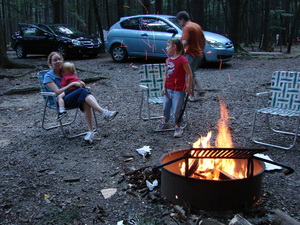So you want to have a nice fire in the pit in your backyard, but you’ve had some trouble getting fires lit and keeping them lit? Fire is nothing to laugh at. It can be dangerous as well as wonderful, but you must build it carefully and tend it properly. Here are some tips to having a good fire that will need minimal tending and give lots of light and warmth:
Where are you building your fire? Start with the pit, brazier, or barbeque itself. Rake out old coals and ash, and examine any rocks or bricks for heat cracks. Dispose of any that seem compromised. Check your brazier for rust. Be sure the structure is hardy and can withstand fire. If it crumbles, it is no longer safe to make a fire in. Check your bed. Is the soil moist, or muddy? If so, spread a bed of tiny twigs, dry grass, or dry vines across it to shield your tinder (the wood that will start the fire) from the moist soil. It’s okay if it looks like a nest; this is as it should be. Take care not to block off too much air, by making sure that the pit is not packed tightly. Always build your tinder up lightly, leaving lots of gaps for air. If your barbeque has vent holes in the bottom, open them.
Layering the wood: There are grades of wood that you should be aware of. It goes by the thickness of the branch. Kindling is tiny, less than a quarter of an inch wide. The next grade should be ½ inch, the next ¾ inch, and the final will be 1 inch or more. Always build your fire with the kindling first, and then layer the ½ inch on top, as though you are building a raft. Leave spaces in between each twig. Then go in the opposing direction, building another “raft”. Now switch to ¾ inch, and build a much looser raft. If the wood appears to be compressing, stop and do not add any more wood.
Make sure to build a fire of the size that suits the container in which it will be held. Never layer the wood until it overflows. Always build small to start. You can always add more wood once the fire is burning well. Wood that overhangs is a fire hazard. It can get caught on shoes and clothing, or catch fire to the grass surrounding your pit. Safety first: get a bucket of water and have it handy next to the fire.
Use a safe lighting fluid. Most lighter fluid is slow to start and gives you time to get out of the way once the wood has caught fire. Never use gas, or alcohol, or any other combustible liquid other than barbeque lighting fluid. Gas builds up a cloud of vapor over it, which will ignite when lit. You have probably heard the “Woof!” of gas being lit. This is extremely dangerous, and can cause burns, catch fire to the person lighting it, and sometimes can be explosive. Use only enough lighter fluid to soak the surface of your tinder. Over-use will cause flare-ups. Let the fluid soak in for a minute before lighting. Use a long match or barbeque lighter to light at least three corners of your tinder. Light from the bottom, because fire always rises. If the fire does not light right away, you may wish to fan it. Do not lean into it and blow on it. This should only be done when a fire has died after many hours of burning. Instead, try lighting the fire again in a different spot. Sometime wind will play a factor in this. NEVER add more fluid to a fire that has been burning. It may cause dangerous flare-ups.
At this point your tinder should be burning merrily. Now is the time to find the best pieces of wood, two inches or over, to add to your fire. Layer them on top, carefully, so as not to upset the fire or mix it in any way. They will catch shortly. Once the 2-inch has caught, you may opt to add four-inch logs. You can build up the diameter of the wood this way, until your fire has enough fuel to burn without needing tending every few minutes. With sufficient size logs, you will not have to tend it for ½ hour or more.
Tips and tricks: Always store your wood in a dry place, even if it means bagging it in contractor’s bags, a garbage can, or any other water-tight container. Use fire-starters when wood seems damp. They are available at your local store near the briquettes. Select your tinder carefully. Do not use vines that are unidentified. The vines that work the best dried are wild or cultivated grape vines. If you do a lot of pruning on your property, always save these vines cut into 6-inch sections, Be sure that they are well-dried, as their sap can cause flare-ups. They will often start a fire when nothing else does. Choose your wood based upon availability, scent, and whether you intend to barbeque on it. Fruit woods are very good for barbequing, apple being the choicest. Oak burns the longest. Pine and Maple are good, but Pine will sputter and flare-up. One you have coals, rake them to the side of your fire and cook over them. You can continue feeding your fire next to them, so that you will have coals to cook for as many hours as you wish.
One final note: Never leave a fire unattended. Always put out a fire completely before leaving it, stirring water into the coals until no steam or smoke rises. A fire that is out will be completely cold.
